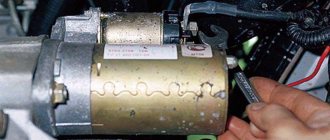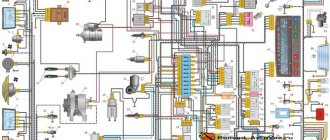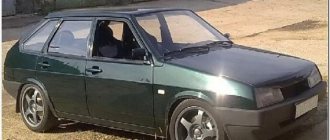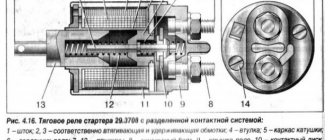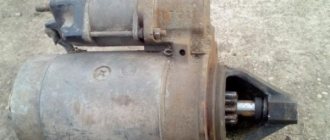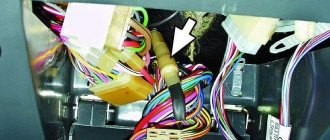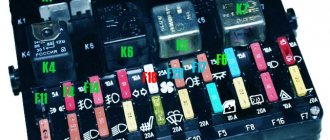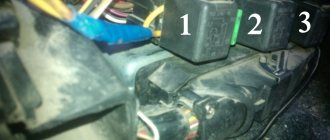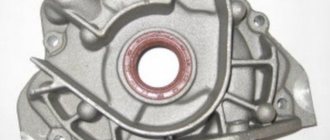Starter relay VAZ 2115
The most likely cause of starter failure is not mechanical damage, but electrical damage. The mechanical part of the starter of the VAZ 2115 car is a retractor mechanism, which works properly throughout the entire operation of the car, only in rare cases does it break down, and only on cars with high mileage. Electrical faults in the starter can be caused by relays, oxidized wire connections, short circuit and other factors.
Where is
If I haven't forgotten, the right one is the starter interlock relay.
Retractor
Self-test of the starter relay
To begin with, before checking the solenoid relay, you need to check the starter itself, since these checks have their own nuances and they must be performed in order to figure out what exactly is not working.
To do this, turn on the ignition switch and turn the key; if the starter does not work, but characteristic clicks are heard, then the relay is working, but the starter is not.
Without removing the starter, if you can get to it, of course, you can check it by jumping the two contacts (copper bolts) on the back cover of the traction relay. If the mechanism spins, the retractor is faulty.
When independently checking, disassembling or repairing various parts, be careful and careful, as this can lead not only to parts breaking, but also to various injuries.
If for some reason you were unable to check it on site, then you will have to dismantle it. When checking, be careful, since the rotation of the mechanism is quite strong, so that it does not break out and cause injury.
Place it near the battery, or preferably on the ground, and use a wire to connect the relay contact terminal to the positive terminal. Using another wire, connect the battery ground to the starter ground.
After the wires touch the terminals, the relay should operate, making a sharp and quick click. If you feel that the relay operates too slowly, then the contacts may be burnt.
Replacement
Before starting work, it is necessary to turn off the power from the battery, because while the electrical circuit is being created, it is prohibited to remove the starter, since you can completely burn out the entire wiring of the car.
— Clean the surface of the starter from dirt and dust;
— Unscrew the nut from the relay bolt and remove its contact;
— Unscrew the screws that secure the relay to the starter body;
— Remove the nuts from the end and divide the starter into 2 parts;
— Remove the old core and put a new one in its place;
— Reassemble all components in reverse order and check serviceability by connecting to the battery;
— Install the starter with the replaced relay on the car engine and check the operation.
Before checking the starter on the VAZ car itself, it is necessary to check that all the contacts that are present in this design are in their correct position and ultimately do not lead to a short circuit, because whatever one may say, we are dealing with current. The operation of the relay is checked first at idle, then while driving, more precisely during sudden braking.
Replacing fuses on a VAZ 2114
When any problems are detected in the operation of the car’s electrical network and engine, be it the burnout of light bulbs or the failure of some electrical devices, the driver must first check the functionality of the fuses. The procedure is as follows:
- determine where the fuses are located on the VAZ 2114, which may have failed. To do this, look in the machine’s operating manual for a diagram of the location of the protective devices and determine whether they are located in the mounting block or under the dashboard in the area where the front passenger’s feet are located;
- when working with the car's electrical system, the negative contact of the battery must be disconnected;
- open the plastic latches holding the mounting block cover;
- remove the plastic tweezers from the mount in the upper right part of the block; they can be red, transparent or yellow;
- take the protective device, the circuit of which is supposed to be broken, by the body with tweezers and pull out the fuse;
- There are rules, developed by operating experience, on how to check the fuse. First of all, it is necessary to visually determine whether the fuse-link inside the case has burned out or whether the charger is in good condition;
- if the destruction of the insert cannot be visually determined, it is necessary to check the protective device using a device;
- If confirmation is received that the fuse has blown, it must be replaced with a functional one. The price for a VAZ 2114 fuse box on the automotive market is about 2,000 rubles, and a set of separate chargers of this type will cost 150 -250 rubles.
Lada 2115 Silver Dream › Logbook › Installing the starter relay
Good morning and evening everyone!
For almost a year, I was periodically tormented by problems with starting the car, especially when it was hot, the solenoid relay kept clicking, the charging sagged and the car, as usual, refused to start. After self-diagnosis, I naturally decided that it was a solenoid relay.
Unscrew the air filter mounts
Then we bend it to the side and hook it onto a pre-prepared wire tied to the hood loop!)) (a critically convenient thing, the former owner of the car suggested this to me).
Then, after spraying a little with WD, we unscrew the starter mounting nuts, I no longer had the lowest nut, it’s likely that the starter had already been removed and so as not to worry about hemorrhoids associated with unscrewing the lowest nut.
Why do you need an ignition relay?
This part was also installed on previous models of VAZ cars. However, on early versions of 2115 it may be absent. It is present in the starter circuit on VAZ-2115-01, 20, 21, 22 (injector, carburetor).
There are different names for this part: ignition relay, starter relay, starter interlock, ignition switch or lock relay, main relay.
But in any case, its purpose is the same - to facilitate engine starting and protect the starter from wear and damage. It turns off the power to the electric starter after starting the engine, limits the currents flowing through it, and protects against caking of contacts in the ignition switch or turning the key while the engine is running.
Decoding fuses and relays of block 2114-3722010-18
VAZ-2114, 2115, 2113 cars of the first models with a carburetor have certain differences in the fuse module.
Old style block fuse and relay diagram
Table 2. Decoding of fuses and relays of block 2114-3722010-18
Left rear headlight
Right taillight dimensions
Light controller
Where is
Where is the VAZ-2115 ignition relay located? It is located in the car interior, to the left of the steering column, under the instrument panel. In order to see it, you need to dismantle the instrument panel. Nearby, to the left of it, there is a relay for turning on the rear fog lights. They are screwed onto the car body stud with a “10” nut and located in special blocks.
The relay also controls the vehicle's washer, heater, rear window defroster, and some other low-current electrical circuits. If these vehicle components are not operating properly, the serviceability of this part should be checked.
The type of electric ignition relay is 90.3777-10, it has four contacts, the control voltage is 12 volts. When buying a new relay, be careful: five-pin analogs designed for 24 volts have a similar appearance. Self-repair of this part is unprofitable due to its low cost.
Video: “Ignition relay VAZ-2115: where is it located?”
Operating principle, design and characteristics of fuses
A protective device of this type consists of a housing, which is usually made of high-strength ceramics or special glass, and a fusible insert made of a conductive metal or alloy.
The body performs several functions:
- a fuse-link is built into it in a special way so that when the rated current of the insert is exceeded, it melts or breaks;
- the working thread is inserted into the chamber to extinguish the electric arc that occurs when the circuit breaks; this chamber is equipped in the housing;
- on the body, in those places and in the form as provided for by the fuse design, there are working contacts through which it must be connected to the general network.
Information about the characteristics of this protective device is printed on the housing. This is the rated current of the fuse link and the rated current of the fuse body at which it breaks.
According to their performance characteristics, these protective elements are divided into:
- fast-acting;
- low voltage;
- designed for medium voltage;
- manufactured for high voltages.
In automotive networks, the first two types are used.
The defining point showing the purpose of a particular protective device with a fuse link is its current characteristics. It is she who speaks about the range in which this element is ready to work.
- To protect electric motors, fuses are installed whose inserts can withstand the rated current and its excess for a sufficiently long time necessary to start the main mechanism and reach its operating range. As a rule, such chargers (protective devices) are marked - g - as devices ready for protection from both overload and short circuit.
- There are protective devices that operate effectively during short circuits and protect all equipment from very high voltage currents. Such chargers are marked - a - for protection only against short circuits.
Fuses for cars have several versions:
- low-current inserts, in networks up to 20 A, made of glass with a thin wire insert, there are ceramic cases, the ends are made of metal;
- fork inserts, most commonly used in vehicles, come in miniature and regular types.
According to GOST, a painting system for fusible chargers has been adopted depending on the rated current of the insert. 2 A - gray, 4 A - pink, 5 A - orange-yellow, 7.5 A - brown, 10 A - red, 15 A - blue, 20 A - yellow, 25 A - white, 30 A - green.
If you installed it yourself
The previous owner of the car, in the absence of such a standard part, could install it himself. Such installation kits are sold in car dealerships. In this case, the electric relay can be located not only in the “standard” location. Finding it without calling the previous owner will not be so easy.
If a breakdown of this part occurs on the way, then you can start the car by closing contacts 87 and 30 (the location and circuit diagram are printed on the top of the relay housing). In this case, you are allowed to use the machine without any restrictions. But at the first opportunity, be sure to fix the breakdown. The operation of the VAZ-2115 ignition system directly depends on the relay.
Where is the ignition relay on the VAZ 2115 and how to find it
After the first unsuccessful attempts to start the car engine with the ignition key, without hearing the usual sounds of the starter, most car enthusiasts look for the cause of the malfunction in its breakdown. However, more often the cause is the ignition relay.
Why do you need an ignition relay?
This part was also installed on previous models of VAZ cars. However, on early versions of 2115 it may be absent. It is present in the starter circuit on VAZ-2115-01, 20, 21, 22 (injector, carburetor).
There are different names for this part: ignition relay, starter relay, starter interlock, ignition switch or lock relay, main relay.
But in any case, its purpose is the same - to facilitate engine starting and protect the starter from wear and damage. It turns off the power to the electric starter after starting the engine, limits the currents flowing through it, and protects against caking of contacts in the ignition switch or turning the key while the engine is running.
In addition, it ensures starting of the starter when the vehicle's electrical equipment is turned on and the battery is slightly discharged.
There are no fuses in the ignition circuit of cars of this model.
Thus, this inexpensive part protects you from expensive repairs and makes it easier to start the engine.
This part should not be confused with the retractor relay, located directly on the starter and intended to control (pulling or pushing) the mechanism for engaging the teeth of the electric starter and the flywheel.
Signs of breakdown
If, when you turn the ignition key, the electric starter does not spin, but you can hear soft clicks of the relay contacts operating, then the cause of the car malfunction is the starter. You can verify this by connecting it directly to the battery, bypassing this electric relay. If clicks are not heard, and the starter is working properly, then it’s time to change it.
Where is
Where is the VAZ-2115 ignition relay located? It is located in the car interior, to the left of the steering column, under the instrument panel. In order to see it, you need to dismantle the instrument panel. Nearby, to the left of it, there is a relay for turning on the rear fog lights. They are screwed onto the car body stud with a “10” nut and located in special blocks.
The relay also controls the vehicle's washer, heater, rear window defroster, and some other low-current electrical circuits. If these vehicle components are not operating properly, the serviceability of this part should be checked.
The type of electric ignition relay is 90.3777-10, it has four contacts, the control voltage is 12 volts. When buying a new relay, be careful: five-pin analogs designed for 24 volts have a similar appearance. Self-repair of this part is unprofitable due to its low cost.
Video: “Ignition relay VAZ-2115: where is it located?”
If you installed it yourself
The previous owner of the car, in the absence of such a standard part, could install it himself. Such installation kits are sold in car dealerships. In this case, the electric relay can be located not only in the “standard” location. Finding it without calling the previous owner will not be so easy.
If a breakdown of this part occurs on the way, then you can start the car by closing contacts 87 and 30 (the location and circuit diagram are printed on the top of the relay housing). In this case, you are allowed to use the machine without any restrictions. But at the first opportunity, be sure to fix the breakdown. The operation of the VAZ-2115 ignition system directly depends on the relay.
VAZ 2115 starter relay: breakdown and replacement method
VAZ 2115 is one of the most worthy creations of the Volga automobile industry. In common parlance, this car is called a tag; it is truly considered one of the most popular and inexpensive cars on the domestic market, produced since 1997. The car earned its popularity quite honestly, since operation and repair do not pose any particular problems to the car owner. However, there are breakdowns that everyone who owns this wonderful car should know about. We will talk about the starter relay, its breakdowns and how to repair it.
What do you need to know about the starter relay for the VAZ 2115?
The starter itself is a four-pole DC motor that is powered by electricity from the battery. A technical inspection of the starter must be done every 100,000 km. Based on the principle of its operation, the starter consumes quite a powerful current, so even minor fluctuations in resistance can significantly reduce its performance and lead to complete breakdown. In order to make sure that the failure is in the relay, it is necessary to do a check. However, before performing this type of check yourself, be very careful to avoid possible injury. We turn on the ignition and turn the key, if the starter does not work, but you can hear some characteristic clicks, this means the relay is working, but the starter itself will have to be disassembled. If the situation is the opposite and when you bridge the contacts on the back wall of the starter without removing it from the engine you will hear the mechanism spinning, then the whole problem is in the relay.
The principle of operation of the VAZ traction relay
The starter coil, which receives power from the battery, creates a magnetic field that acts on the armature. It starts to move, compressing the return spring, which engages the bendix, which connects to the splines of the flywheel crown. The contacts of the elements close, the retracting winding remains without power, but the armature remains inside the coil, as it is held by a strong magnetic field. After the engine starts, the coil loses its power and the armature accordingly returns to its original position. In this case, the bendix itself disengages.
Starter relay malfunction
There are several options for checking the relay, which can be used to determine whether it is faulty.
- When starting the engine, the starter does not turn off on its own. This can easily be determined by the fairly loud and sharp buzzing that can be heard in the interior of the VAZ 2115;
- When you turn the key in the ignition switch, a click is clearly heard, but nothing happens and the starter does not start;
- When you turn the key, the starter allegedly starts working, but the engine does not start.
In most VAZ cars, the relays are similar to each other, differing only in the way they are attached to the starter. And unfortunately, breakdowns that specifically affect the relay in 95% of cases end in its replacement. But still, before making this diagnosis, you need to make sure of one more serviceability, namely the functionality of the contacts at the place where the wire and terminal are soldered. Often, due to oxidation, the contact is lost, and by soldering it again, you can get rid of the problem of the starter relay breaking, provided that after this procedure the car is fully operational.
For a VAZ 2115, it is more cost-effective to replace the relay than to repair it to the point where it works properly.
Any service station will help you perform such a replacement, but this pleasure is relatively expensive. A much cheaper way would be to do everything yourself. If the owner of the car knows his ward 2115 inside and out, then such a replacement can be made independently without much effort, knowing the specific sequence of actions.
Where is the starter relay on the VAZ-2114: photo and location + video
If for some reason your car has stopped starting (turning the engine - approx.), then first of all you need to pay attention to the condition of the starter relay. However, there are two of them in this device, which are radically different both in design and in their purpose.
In this article we will look at each of them in detail, talk about their purpose and location in the car.
Starter relay (retractor) for VAZ-2114
This type of relay is located directly on the starter housing, and is controlled by supplying current from the ignition switch.
This type of relay is directly involved in starting the engine, regulating the clutch reaction between currents of different magnitudes (since the ignition voltage is less than the current supplied from the battery - approx.).
Solenoid relay location
It is not difficult to determine the location of the retractor; it is located directly on the starter and has two wires, the first, the smallest in size, comes from the ignition switch, and the second, the largest in size, comes from the battery.
The location of the wires is indicated by arrows.
The relay is located directly on the starter housing.
Relay operating principle
The operation of this relay is as follows:
- When the battery supplies current to the starter coil, due to the magnetic field, the coil acts on the armature.
- When the armature moves, it clamps the spring, from which the bendix is connected to the splines.
- When the contacts close together, the engine starts, and all connections return to their places, disconnecting the fixation points.
Solenoid relay malfunctions and their symptoms
You can first see if there are problems with the solenoid relay visually, since there may be traces of corrosion on the wires, and as a result, the incoming current may simply not pass to its destination. If cleaning these contacts does not lead to anything, then we move on to inspecting the 4-pin relay, usually located on a bolt in the engine compartment.
The relay location is indicated by a red marker.
Four-pin relay for starter
Another relay that is included in the starter electrical circuit is a conventional four-pin relay, which is responsible for the reliability and integrity of the circuit as a whole.
This is what the relay looks like up close.
Relay diagnostics and faults
In order to diagnose a relay, inspect it for corrosion, and to check its functionality for sure, simply replace it with a known working device. The most common reason for the malfunction of this relay will be the absence of “cranking” and any starter signals after turning the key in the ignition switch.
Relay replacement: sequence
Before starting work, it is necessary to turn off the power from the battery, because while the electrical circuit is being created, it is prohibited to remove the starter, since you can completely burn out the entire wiring of the car.
- Clean the surface of the starter from dirt and dust;
- Unscrew the nut from the relay bolt and remove its contact;
- Unscrew the screws that secure the relay to the starter body;
- Remove the nuts from the end and divide the starter into 2 parts;
- Remove the old core and put a new one in its place;
- Reassemble all components in reverse order and check serviceability by connecting to the battery;
- Install the starter with the replaced relay on the car engine and check the operation.
Before checking the starter on the VAZ car itself, it is necessary to check that all the contacts that are present in this design are in their correct position and ultimately do not lead to a short circuit, because whatever one may say, we are dealing with current. The operation of the relay is checked first at idle, then while driving, more precisely during sudden braking.
Thus, following the exact recommendations, you can replace the starter relay yourself, but before you start removing and disassembling the starter itself, you need to check the indicators described above and make sure that the whole problem is in this particular part of the car, otherwise the wasted effort will not solve the main problem. Problems. If you haven’t identified the problem, then experienced service station employees will always help and do everything necessary for you!
